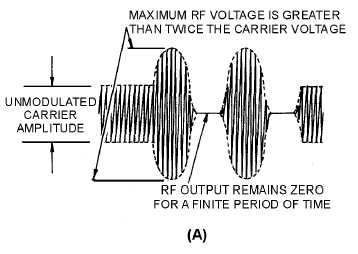1-47
Figure 1-41A.—Overmodulation conditions.
Look carefully at the modulation envelope in view (A). It shows that the negative peak of the
modulating signal has effectively been limited. If the signal were demodulated (detected in the receiver),
it would have an appearance somewhat similar to a square wave. This condition, known as
OVERMODULATION, causes the signal to sound severely distorted (although this will depend on the
degree of overmodulation).
Overmodulation will generate unwanted (SPURIOUS) sideband frequencies. This effect can easily
be detected by tuning a receiver near, but somewhat outside the desired frequency. You would likely be
able to tune to one or more of these undesired sideband frequencies, but the reception would be severely
distorted, possibly unintelligible. (Without overmodulation, no such unwanted sideband frequencies
would exist and you would be able to tune only to the desired frequency.) These unwanted frequencies
will appear for a considerable range both above and below the desired channel. This effect is sometimes
called SPLATTER. These spurious frequencies, shown in view (B), cause interference with other stations
operating on adjacent channels. You should clearly understand that overmodulation, and its attendant
distortion and interference is to be avoided.
Figure 1-41B.—Overmodulation conditions.
In addition to the above problems, overmodulation also causes abnormally large voltages and
currents to exist at various points within the transmitter. Therefore, sufficient overload protection by



